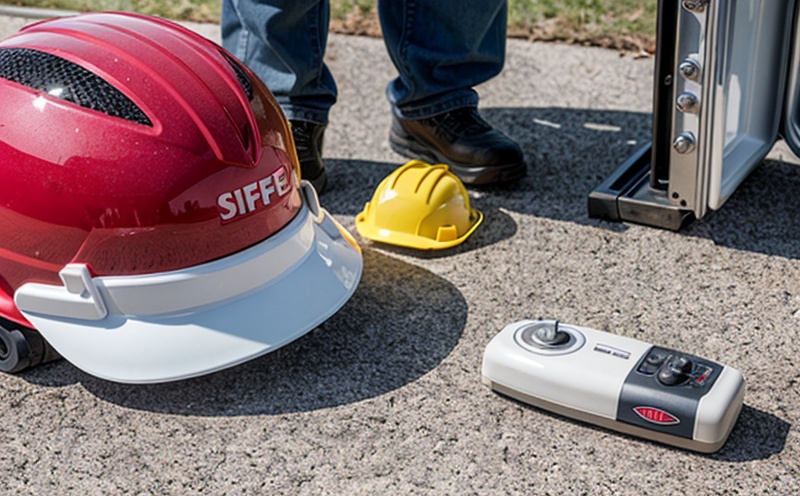ISO 15736 Liferaft Inflation System Testing
The ISO 15736 standard is a critical benchmark for ensuring that liferafts are capable of safely and reliably inflating in marine environments. This test evaluates the integrity, functionality, and performance of the inflation system within liferafts used in maritime applications. Compliance with this international standard ensures that life-saving appliances meet rigorous safety requirements, thereby protecting the lives of crew members and passengers.
During testing, a specialized apparatus is employed to simulate real-world deployment scenarios. The test involves subjecting the liferaft’s inflation system to various environmental conditions, including temperature variations and exposure to saltwater. This ensures that the system performs optimally under the conditions it may encounter during an emergency. The objective of this testing process is to assess whether the inflation system can reliably inflate the liferaft within a specified time frame and at the correct rate.
The test protocol strictly adheres to ISO 15736 guidelines, which outline specific criteria for evaluating the performance of inflating systems in liferafts. These include measuring the time taken from activation to full inflation, ensuring that the inflated volume meets predefined specifications, and verifying that there are no leaks or malfunctions during the process. The test setup also includes a detailed inspection of all components involved in the inflation sequence, including the CO2 cartridges, valves, and inflating hose.
The significance of this testing cannot be overstated, especially given the critical role liferafts play in maritime safety. In case of an emergency at sea, the reliability of the inflation system is paramount. A poorly performing system could lead to delays or even failure during deployment, which would compromise the effectiveness of the liferaft as a life-saving device.
In addition to the physical testing, there are also stringent acceptance criteria that must be met for the inflatable system to pass this test. These include ensuring that the inflation process is completed within 30 seconds from activation and that the final volume of the inflated liferaft meets the prescribed dimensions specified in ISO 15736. Any deviation from these standards could lead to the rejection of the product.
For R&D engineers, quality managers, and compliance officers responsible for ensuring maritime safety, this testing is a crucial step in guaranteeing that liferafts are fit for purpose. By adhering to ISO 15736 guidelines, manufacturers can ensure that their products meet industry standards and regulatory requirements. This not only enhances the reliability of the product but also helps in maintaining a high level of trust with customers and stakeholders.
The real-world application of this testing is evident when considering maritime accidents or emergencies where every second counts. In such scenarios, the performance of liferafts can be the difference between life and death. By undergoing rigorous ISO 15736 testing, manufacturers can ensure that their products are not only compliant with international standards but also reliable under real-world conditions.
In summary, ISO 15736 Liferaft Inflation System Testing is a vital process in ensuring the safety of maritime operations. It involves simulating deployment scenarios and evaluating the performance of the inflation system based on strict criteria outlined by the standard. This testing not only enhances product reliability but also plays a crucial role in protecting lives at sea.
Why It Matters
The ISO 15736 Liferaft Inflation System Testing is essential for ensuring that liferafts are capable of reliably inflating under the most challenging marine conditions. This testing process is not only a regulatory requirement but also a critical component in maintaining maritime safety standards.
- Regulatory Compliance: Adherence to ISO 15736 ensures compliance with international maritime regulations, which is crucial for manufacturers and operators of liferafts.
- Enhanced Reliability: The testing process simulates real-world conditions, ensuring that the inflation system functions correctly under various environmental factors.
- Life-Saving Assurance: In case of an emergency at sea, a reliable inflation system is critical for ensuring that liferafts deploy promptly and effectively.
The importance of this testing cannot be overstated. It helps in identifying any potential issues with the inflation system before they become critical during actual deployment. This proactive approach ensures that manufacturers can address any shortcomings and improve product quality, thereby enhancing maritime safety standards globally.
For R&D engineers and compliance officers involved in liferaft development and certification, this testing is a cornerstone of their work. It provides valuable insights into the performance characteristics of the inflation system and helps in making informed decisions regarding design modifications or improvements. By focusing on these aspects, they can ensure that their products meet not only regulatory requirements but also exceed industry expectations.
Moreover, the results from ISO 15736 testing are crucial for quality managers overseeing production processes. These results help them to identify any discrepancies between actual performance and expected outcomes, allowing for timely corrective actions. This ensures consistent quality across all batches of liferafts produced by manufacturers, further reinforcing maritime safety standards.
In conclusion, the ISO 15736 Liferaft Inflation System Testing is a fundamental step in ensuring that liferafts are reliable and effective when needed most. It plays an indispensable role in maintaining maritime safety standards and protecting lives at sea.





